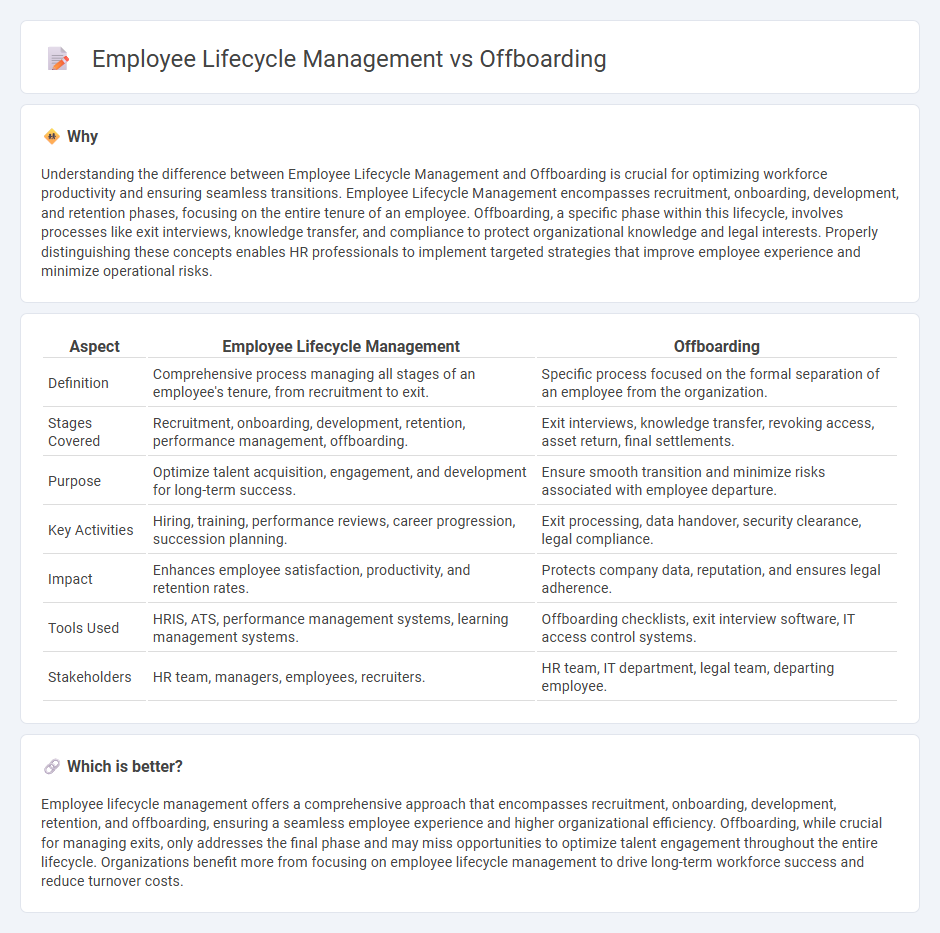
Employee lifecycle management encompasses all stages of an employee's tenure, from recruitment and onboarding to development and retention, ensuring a cohesive experience aligned with company goals. Offboarding specifically addresses the processes involved when an employee exits the organization, focusing on knowledge transfer, compliance, and exit interviews to maintain operational continuity. Explore in-depth the strategic differences and impacts of employee lifecycle management versus offboarding.
Why it is important
Understanding the difference between Employee Lifecycle Management and Offboarding is crucial for optimizing workforce productivity and ensuring seamless transitions. Employee Lifecycle Management encompasses recruitment, onboarding, development, and retention phases, focusing on the entire tenure of an employee. Offboarding, a specific phase within this lifecycle, involves processes like exit interviews, knowledge transfer, and compliance to protect organizational knowledge and legal interests. Properly distinguishing these concepts enables HR professionals to implement targeted strategies that improve employee experience and minimize operational risks.
Comparison Table
| Aspect | Employee Lifecycle Management | Offboarding |
|---|---|---|
| Definition | Comprehensive process managing all stages of an employee's tenure, from recruitment to exit. | Specific process focused on the formal separation of an employee from the organization. |
| Stages Covered | Recruitment, onboarding, development, retention, performance management, offboarding. | Exit interviews, knowledge transfer, revoking access, asset return, final settlements. |
| Purpose | Optimize talent acquisition, engagement, and development for long-term success. | Ensure smooth transition and minimize risks associated with employee departure. |
| Key Activities | Hiring, training, performance reviews, career progression, succession planning. | Exit processing, data handover, security clearance, legal compliance. |
| Impact | Enhances employee satisfaction, productivity, and retention rates. | Protects company data, reputation, and ensures legal adherence. |
| Tools Used | HRIS, ATS, performance management systems, learning management systems. | Offboarding checklists, exit interview software, IT access control systems. |
| Stakeholders | HR team, managers, employees, recruiters. | HR team, IT department, legal team, departing employee. |
Which is better?
Employee lifecycle management offers a comprehensive approach that encompasses recruitment, onboarding, development, retention, and offboarding, ensuring a seamless employee experience and higher organizational efficiency. Offboarding, while crucial for managing exits, only addresses the final phase and may miss opportunities to optimize talent engagement throughout the entire lifecycle. Organizations benefit more from focusing on employee lifecycle management to drive long-term workforce success and reduce turnover costs.
Connection
Employee lifecycle management encompasses all stages from recruitment to offboarding, ensuring seamless transitions and consistent engagement. Offboarding, as the final phase, facilitates knowledge transfer, compliance with legal requirements, and maintains positive employer-employee relationships. Effective integration of offboarding processes within the employee lifecycle enhances organizational retention strategies and reduces risks associated with exits.
Key Terms
Exit Interviews
Exit interviews serve as a critical component of both offboarding and employee lifecycle management by capturing valuable feedback to improve workplace culture and retention strategies. Offboarding focuses on the processes related to an employee's departure, including knowledge transfer, compliance, and administrative tasks, while employee lifecycle management encompasses all stages from recruitment to exit. Explore how integrating comprehensive exit interviews enhances your organization's talent management framework and strategic decision-making.
Knowledge Transfer
Offboarding and employee lifecycle management both prioritize knowledge transfer to maintain organizational continuity and reduce knowledge loss. Effective knowledge transfer during offboarding captures critical skills and insights through documentation, mentoring, and handover processes. Explore best practices and tools to enhance knowledge transfer within your organization's lifecycle management.
Succession Planning
Succession planning is a critical component of employee lifecycle management, ensuring seamless transitions and continuity in key roles. Offboarding focuses on exit processes while succession planning proactively identifies and develops internal talent for future leadership. Explore effective strategies to integrate succession planning within the entire employee lifecycle management framework.
Source and External Links
Employee offboarding - Wikipedia - Employee offboarding is the process when an employee leaves a company, involving knowledge transfer, exit interviews, return of company property, and security and compliance steps to mitigate risks and ensure a smooth separation.
Offboarding | Deel - Offboarding is an HR process that officially separates an employee from their employer, aiming to maintain positive relations, secure company assets, transfer knowledge, and minimize disruption, usually occurring during the employee's last week.
What is offboarding? Best practices & steps - HiBob - Offboarding is a structured process to disengage an employee from their role, minimizing company disruption, protecting confidential information, collecting feedback, and sometimes offering outplacement services to support the transition.
 dowidth.com
dowidth.com